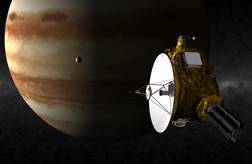| HOME | DATA & SERVICES | ABOUT THE ATMOSPHERES NODE | CONTACT US | SITE MAP | RELATED SITES |
![]()
|
Welcome to the Planetary Data System Atmospheres Node
The New Horizons spacecraft, launched in January 2006, was designed to study small worlds in our outer solar system. It will fly by Pluto and its large moon Charon in July 2015, and from there will continue onward to encounter another Kuiper Belt Object. In February 2007, New Horizons flew past Jupiter for a gravity assist, which aided the spacecraft in getting on its trajectory to Pluto. As it flew by Jupiter, New Horizons tested out its instruments and collected science data along the way. The New Horizons spacecraft is equipped with seven instruments designed to study the atmosphere and surface of Pluto and its environment. More detailed information about the individual instruments and their data sets can be found below.
Image Credit: The science data that were acquired by New Horizons during its Jupiter encounter was focused on four aspects of the Jupiter system: the Jovian atmosphere, Jupiter's moons, its ring system, and its magnetosphere. The Jupiter science opportunities web page on the New Horizons web site contains more information about the Jupiter encounter.
The New Horizons Jupiter data were delivered to the PDS. The PDS must still validate these data before they are considered archived, although the data are online provisionally while they are being validated. The PDS urges caution when using any data that have been released to PDS for less than three months. Also be aware that some of the links below may not yet be operational or may lead to incomplete web pages until the data have been delivered and validated. The New Horizons spacecraft is equipped with the following instruments: The Small Bodies Node is the PDS lead archiving node for New Horizons and is responsible for archiving all of the Jupiter flyby data in addition to all of the Pluto encounter data. The LORRI images from the Jupiter encounter are also being made available from the New Horizons Science Operations Center. For those interested in advanced navigational information from the New Horizons Jupiter Encounter, the SPICE Kernel may be found here. Instruments and Data Follow the instrument links above to find information about the New Horizons data products online. For a brief overview of each instrument's parameters, consult the table below.
Data from the New Horizons mission has also been made available through PDS-D, the Planetary Data System online distribution service. Subscribe to the PDS Subscription Service to be informed of new data releases. More information about the mission can be found on the New Horizons web site. Preprints of the New Horizons Space Science Reviews papers, containing detailed information about the mission, the spacecraft, and the instruments, can be found either here, or alternately in the "about" section of each of the instruments specific pages above. |
